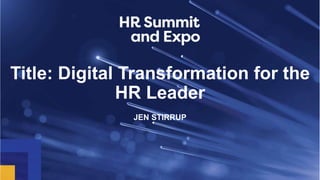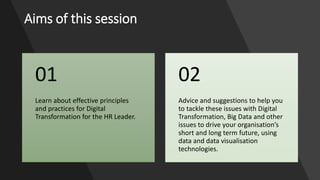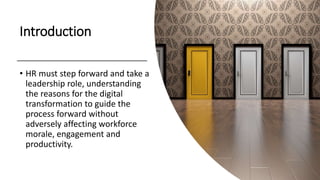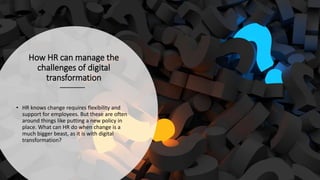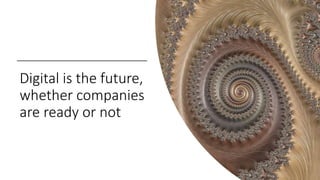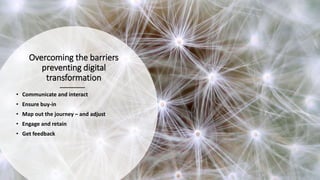Digital Transformation for the Human Resources Leader
- 1. Title: Digital Transformation for the HR Leader JEN STIRRUP
- 2. Jen Stirrup Data Whisperer Data Relish UK Postgrad in Artificial Intelligence Universities in the UK and Paris AI and BI Consultant for 20 years Global delivery of projects Author Published author on Business Intelligence technology boos • /jenstirrup • @jenstirrup • jenstirrup
- 3. Aims of this session Learn about effective principles and practices for Digital Transformation for the HR Leader. 01 Advice and suggestions to help you to tackle these issues with Digital Transformation, Big Data and other issues to drive your organisation’s short and long term future, using data and data visualisation technologies. 02
- 4. What is Digital Transformation • As part of the Digital Transformation story, data can help to bring clarity and predictability to the HR leader to make strategic decisions, understand how their customers and employees behave, and measure what really matters to the HR team and the organisation overall.
- 5. Introduction • HR must step forward and take a leadership role, understanding the reasons for the digital transformation to guide the process forward without adversely affecting workforce morale, engagement and productivity.
- 6. How HR can manage the challenges of digital transformation • HR knows change requires flexibility and support for employees. But these are often around things like putting a new policy in place. What can HR do when change is a much bigger beast, as it is with digital transformation?
- 7. Digital is the future, whether companies are ready or not
- 8. Overcoming the barriers preventing digital transformation • Communicate and interact • Ensure buy-in • Map out the journey – and adjust • Engage and retain • Get feedback
- 9. Roadmap • The process of adopting a new digital HR platform can be delicate for many reasons. • Selecting the right software for your business requires a great deal of research and analysis. • Put the business first, technology second. • Technology is an enabler for the business • Don’t be afraid to try proof of concept projects • Be clear on your primary success factors • Success leaves clues
- 11. Conclusion • The technical implementation itself is extremely intricate. But the most complex variable of all are your employees; how do they react to HR software changes, especially if they have to adopt new behaviours post-implementation? Your job as an HR professional is not only to ensure that they embrace the changes, but that the changes improve the working lives of you employees.
- 12. Thank you!
Editor's Notes
- Today, CIOs and other business decision-makers are increasingly recognizing the value of open source software and Azure cloud computing for the enterprise, as a way of driving down costs whilst delivering enterprise capabilities. For the Business Intelligence professional, how can you introduce Open Source for analytics into the Enterprise in a robust way, whilst also creating an architecture that accommodates cloud, on-premise and hybrid architectures? We will examine strategies for using open source technologies to improve existing common Business Intelligence issues, using Apache Spark as our backdrop to delivering open source Big Data analytics. - incorporating Apache Spark into your existing projects - looking at your choices to parallelize Apache Spark your computations across nodes of a Hadoop cluster - how ScaleR works with Spark - Using Sparkly and SparkR within a ScaleR workflow Join this session to learn more about open source with Azure for Business Intelligence
- QUESTIONS: How is your current Digital Transformation strategy performing? Are you part of an organisation which is struggling to know how to deal with your data? Do you think that you might have a Big Data problem, but you're not really sure where to start? How do you get the experience, skills or techniques to get it right, faster and within budget?
- Digital Transformation is a hot topic with CEOs and the C-level suite, renewing their interest in data and what it can do to empower the organisation. A recent survey showed: Fifty-six percent of companies are redesigning their HR programs to leverage digital and mobile tools. Fifty-one percent of companies are currently in the process of redesigning their organisations for digital business models. Thirty-three percent of surveyed HR teams are using some form of artificial intelligence (AI) technology to deliver HR solutions, and 41 percent are actively building mobile apps to deliver HR services (https://www2.deloitte.com/content/dam/Deloitte/at/Documents/about-deloitte/global-human-capital-trends-2017.pdf)
- A recent survey showed: Fifty-six percent of companies are redesigning their HR programs to leverage digital and mobile tools. Fifty-one percent of companies are currently in the process of redesigning their organisations for digital business models. Thirty-three percent of surveyed HR teams are using some form of artificial intelligence (AI) technology to deliver HR solutions, and 41 percent are actively building mobile apps to deliver HR services (https://www2.deloitte.com/content/dam/Deloitte/at/Documents/about-deloitte/global-human-capital-trends-2017.pdf)
- A 2017 IDC study titled Future business: Unleashing your talent, sponsored by Cornerstone OnDemand, unveiled how digital transformation is impacting HR, and how HR and line managers view it. The study found that cultural resistance to change was the primary barrier to digital transformation. This was followed – perhaps unsurprisingly – by legacy IT systems and retaining critical talent. Interestingly, the study also found that high-growth organisations have a higher frequency of interaction between HR and line of business managers, and also better alignment between HR and IT, so it’s crucial HR helps overcome the barriers preventing digital transformation. After all, digital is the future, whether companies are ready or not.
- Shifting gears towards digital business models is something that requires fundamental change to core organisational processes and the way that employees work day-to-day. It’s disruptive, and many European organisations are now facing the challenges digital transformation imposes head on.
- Communicate and interact Effective cultural change required frequent and effective communication within your organisation. Be sure to use all the available channels you have to foster this transformation, and do not rely on static means of interaction. Instead, focus on providing opportunities for an open conversation as much as possible. Ensure buy-in Engage the leadership team to drive the cultural change in your organisation, ensuring buy-in from the higher echelons within the organisation. Your HR team cannot accomplish this change by itself and will need the support of the C-suite, along with the understanding of all stakeholders across the employee spectrum, in order to be successful with digital transformation. Map out the journey – and adjust Research and provide best practices, examples and visible roadmaps for digital transformation that lead to culture shift, while simultaneously ensuring that culture change is being monitored, readjusted, and tracked within your organisation. This will give your organisation a clear idea of how digital transformation can and should play out, and hopefully break down any barriers that are currently in the way. Engage and retain Retaining your key talent is pivotal while digital transformation occurs. Design and implement a comprehensive strategy that will keep the highly skilled and valuable talent of the organisation engaged and committed to the long-term vision of your company, and they will help steer the successful digital transformation journey. Get feedback Aside from having a plan to retain talent, you need to pay regular attention to the level of satisfaction and the perception of the organisation among employees both internally and externally, ensuring that happiness and pride are common and well founded. Employer branding is critical in the acquisition and retention of talent, and a few bad reviews on Glassdoor about your company can stop you making a great new hire.
- The secrets to leading your staff happily through a period of digital HR transformation to a better future are: Identify problems that need to be solved Make sure a new system answers existing problems Train your workforce on a new platform Get enthusiastic buy-in, by making sure benefits are well-communicated Keep employee engagement high throughout the transformation Co-create solutions by bringing your workforce into the process
- The secrets to leading your staff happily through a period of digital HR transformation to a better future are: Identify problems that need to be solved Make sure a new system answers existing problems Train your workforce on a new platform Get enthusiastic buy-in, by making sure benefits are well-communicated Keep employee engagement high throughout the transformation Co-create solutions by bringing your workforce into the process

